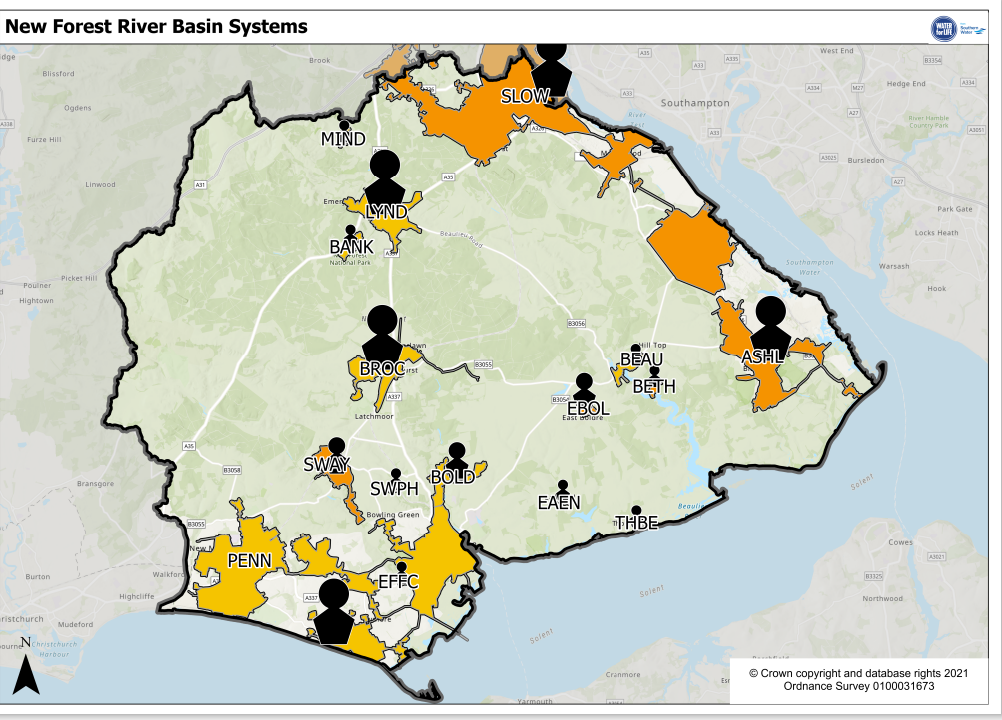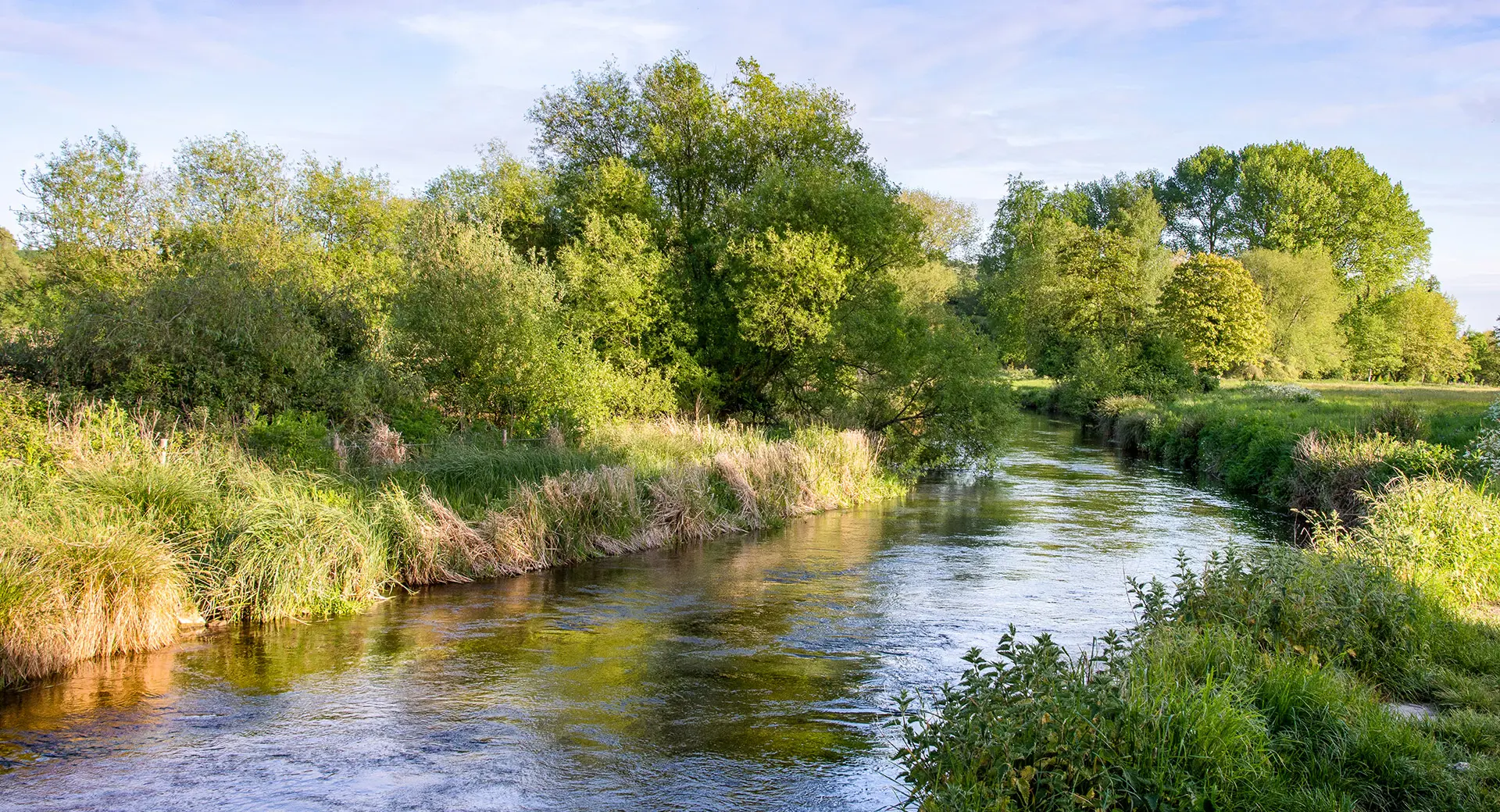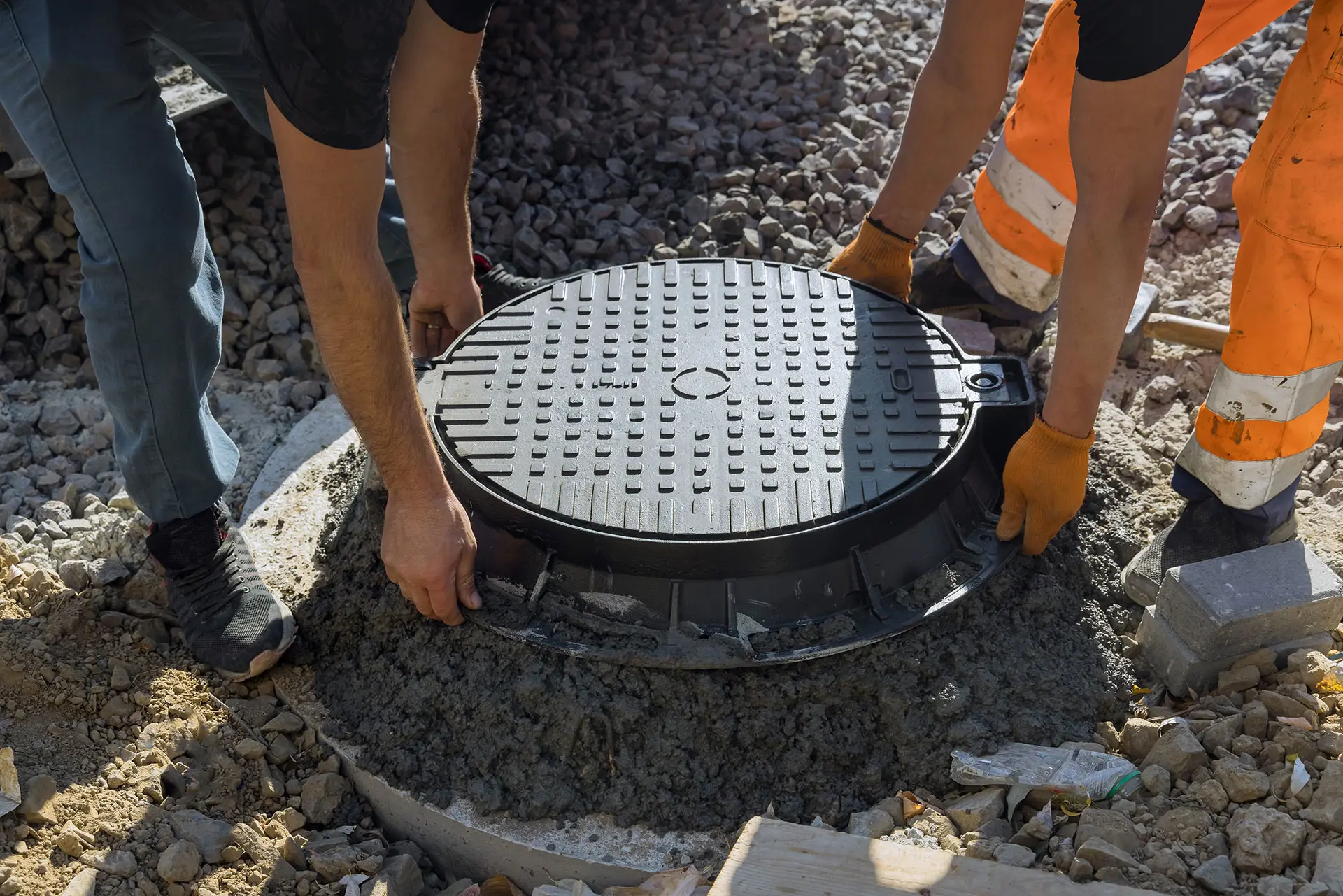1. Overview for the New Forest Catchment
You can find all the documents relating to the below in the downloads at the bottom of this page.
Our DWMP sets out our priorities for the New Forest River Basin Catchment.
- Reducing the number of spills from the 30 storm overflows which together currently spill around 600 times per annum.
- Separating or attenuating excess rainwater in the sewer networks to reduce the risks of flooding and frequency of storm overflow discharges, especially in Marchwood and Boldre.
- Investigating the potential impact of wastewater discharges on the Solent and Dorset Coast, Solent Maritime and Southampton Water and identify the requirements to achieve Nutrient Neutrality and Good Ecological Status/Potential.
- Investigating the impact of wastewater discharges on the shellfish waters in Ashlett Creek, Slowhill Copse Marchwood and Southampton Water.
- Planning for potential significant developments at Totton and the Old Power Station, Fawley.
- Improving the resilience of our networks and treatment works to prevent pollution incidents, particularly in Totton and Marchwood.
Across the New Forest we have:
All the stages we followed in developing the DWMP for the New Forest are set out in the subsections below.
Across the New Forest we have:
All the stages we followed in developing the DWMP for the New Forest are set out in the subsections below.
16
Sewerage catchments
1,142
Kilometres of sewers
16
Wastewater Treatment Works
126
Wastewater Pumping Stations
11%
The percentage of the region connected to a mains sewer
92%
The percentage of homes connected to a mains sewer
86%
The percentage of businesses connected to a mains sewer
2. Working with others
We've worked with a wide range of organisations with responsibilities for drainage, flooding and protection of the environment while developing our DWMP. The organisations we worked with in the New Forest River Basin Catchment include:
- Hampshire County Council
- The New Forest National Park Authority
- Fareham Borough Council
- New Forest District Council
- The Environment Agency
- Natural England
- The New Forest Catchment Partnership and member organisations including:
- Country Landowners Association
- Forestry England
- Freshwater Habitats
- Hampshire and Isle of Wight Wildlife Trust
Working together to co-create the DWMP is important. Our drainage and wastewater systems are often interconnected with the systems managed and operated by others and affect the natural environments within the catchment.
Issues and concerns
A wide range of issues and concerns have been raised and discussed throughout the development of the DWMP for the New Forest. We're progressing these issues through the development of the DWMP as set out in our investment needs for the New Forest. Furthermore, we commit to working with others to co-develop and co-deliver schemes that meet multi-organisational objectives and which benefit the environment, our customers and communities.
3. Workshop presentations
We developed and ran a series of activities between 2020 and 2022 as we prepared our DWMP for the New Forest. This included regionally-based workshops that presented and discussed issues and information relevant across the whole of our operating region.
You can view the presentations used in the webinars on our Who we’re working with page.
Workshop 1
Held in September 2020, participants discussed the findings of the risk based catchment screening (RBCS) and proposed additional planning objectives for the DWMP.
Workshop 2
Held in May 2021, participants:
- discussed the results from the BRAVA risk assessments and the proposed investment strategy for the wastewater catchments within the River Basin
- identified the generic options that should be explored to address the identified risks, and
- discussed which wastewater catchments to progress through the Options Development and Appraisal stage of the DWMP.
Workshop 3
Held in March 2022, we reviewed and discussed the draft investment programme for the New Forest River Basin Catchment. This included the types of investment, priorities and timing for investment needs and the wider opportunities arising from the proposed investment in terms of partnership projects and catchment-wide solutions providing multiple benefits.
You can view the findings from our interim consultation.
4. Risk based catchment screening for the New Forest
Risk based catchment screening (RBCS) is a process that uses readily available data. This data helps us to identify where there's a current and/or potential risk or vulnerability in the sewer catchment to future changes, such as new residential development or changes in climate. This enables effort to be focused on these catchments during the development of the DWMP in order to understand these risks in more detail and why they're likely to occur.
The RBCS involves the assessment of each sewer catchment against 17 indicators set out in guidance published by Water UK. Water companies can add additional indicators to ensure that other important issues are highlighted at this early stage in the development of the DWMPs. We've included an additional metric on customer complaints as this provides a flag for catchments with ongoing or outstanding concerns.
Find out more about the risk based catchment screening process.
5. BRAVA for the New Forest
The Baseline Risk and Vulnerability Assessment (BRAVA) is an important step in the development of our DWMP. This assessment helps us understand current system performance and future vulnerabilities. Understanding these risks means that we can identify the investment needed to manage and reduce the risks to band 0 (no significant level of risk).
We've completed a BRAVA assessment for each of the wastewater systems in the New Forest Catchment that were flagged during the RBCS. A risk assessment is completed for all 14 planning objectives.
The output of the BRAVA shows:
- the current risks and issues in each wastewater system within the New Forest catchment – providing a baseline from which we can assess future risks
- the future risks in 2030, 2035, 2045 and 2050 (where the methodology currently allows us to assess the future risks) so we can understand how the current risks may change without additional investment
- the key issues behind the future changes in risk, including:
- a deterioration in the condition of our wastewater systems
- climate change – including the increasing frequency and severity of droughts and storms
- growth and urban creep
- a combination of any or all of these that are relevant in the catchment being assessed.
6. Problem Characterisation
The Problem Characterisation stage of the DWMP uses the results from the Baseline Risk and Vulnerability Assessment (BRAVA) to explore the causes of risks and the primary drivers. A technical summary provides information on our approach to the Problem Characterisation stage.
Current risks in the New Forest Catchment
The combined results of the 2020 BRAVA assessment for all 16 wastewater systems in the New Forest River Basin Catchment shows how many wastewater systems have a risk under each of the 14 planning objectives. For example, for the risk of internal flooding, 13 wastewater systems are in band 0 (not significant), one is in band 1 (moderately significant), none are in band 2 (very significant) and two were ‘not flagged’ for inclusion (i.e. screened out at the RBCS of the DWMP).
Storm overflows and nutrients are the main concerns in this river basin based on the BRAVA results for 2020.
The wastewater system with the highest number of planning objectives in band 2 (very significant) is Slowhill Copse Marchwood with five objectives in band 2. All other systems have two or fewer band 2 risks.
The specific risks and the causes of risk for each of the wastewater systems are explained in the summary of the problem characterisation for each system.
Future risks in the New Forest Catchment
The 2050 BRAVA results help us to identify the future challenges for drainage and wastewater management in the New Forest River Basin Catchment.
(a) Growth
There are several wastewater catchments where new homes, businesses, roads and other infrastructure are planned. The main areas identified for potential new development in the New Forest Catchment are:
- Slowhill Copse Marchwood (2000+ Homes)
- Pennington (1000+ Homes)
- Ashlett Creek Fawley (1000+ Homes)
The BRAVA results show that the additional homes and businesses will increase the risks of non-compliance with our Dry Weather Flow (DWF) permits from the Environment Agency in a number of the wastewater systems. This includes Slowhill Copse Marchwood, Brockenhurst and Flexford Lane Sway. This means further investment will be needed in the future to increase the capacity of our treatment works to accommodate the new homes and businesses.
New development in the New Forest might put additional pressure on internationally designated habitat sites such as the Solent and Dorset Coast. So, solutions will need to be found to ensure that development is nutrient neutral.
A map of the New Forest Catchment showing the estimated future growth in each wastewater system is shown below.

(b) Climate change
Climate change will bring greater variability of our weather with warmer wetter winters and hotter drier summers. As a result, we could be seeing more intense summer storms that exceed the capacity of the drainage and wastewater networks and cause localised flooding. Hence, the risk of flooding from sewer systems is increasing due to climate change. The technical summary explains how we have incorporated climate change into our DWMP.
We'll work with partner organisations, such as Hampshire County Council and the Environment Agency, who have responsibility for flooding and drainage, to consider options and develop opportunities to find solutions that reduce the risks from flooding.
We'll need to adapt our wastewater systems to operate in future climates. There will be an increasing need to slow the flow entering our sewer networks so the systems can carry the water without flooding homes and businesses and/or without causing discharges from storm overflows. Preventing additional rainfall from entering foul sewer networks, including combined sewer networks where possible, could delay the need to upgrade and enlarge the vast underground network of sewers.
Climate change is expected to increase the risk of flooding in the Pennington wastewater system to 'significant' by 2050. The risk of storm overflow discharges is also forecast to increase to 'significant' for the Ashlett Creek Fawley wastewater system. Eight other systems already have a very significant risk in this river basin as illustrated by the BRAVA results.
The map below highlights the potential impact of climate change on each of our wastewater systems. It shows the impact of climate change, urban creep and growth on the risk of flooding in a 1-in-20-year storm. We followed Water UK’s capacity assessment framework to apply a 20% uplift to rainfall forecasts to assess the potential increases in flood volumes shown on the map. Urban creep was estimated using the approach developed by the UK Water Industry Research (UKWIR) report on Urban Creep in sewerage systems (2010).

The map highlights that the flood volumes are relatively small in the wastewater systems, but the 20% increase in rainfall actually almost doubles the flood volumes. It demonstrates that we'll need to adapt to climate change. Adaptation will mean considering long-term sustainable options, such as reducing the volume of rainwater entering the sewer network. This approach may provide the capacity within the wastewater system to allow for future growth, and therefore reduce both the need for significant increases in the capacity of the existing wastewater systems and reduce discharges from storm overflows.
Investment planning for each wastewater system
We used the BRAVA results and our understanding of the causes of risks and drivers to propose an investment strategy for each of the wastewater systems. Find out more information on how we determined the investment strategies. These strategies help us to target the wastewater systems that need further investment to reduce the potential risks to customers and the environment. We've produced a table that lists the proposed investment strategy for each catchment.
We used a risk-based approach to identify the wastewater systems that we need to progress in this first round of DWMPs. For these systems, we will develop an investment plan. Our technical summary sets out how we selected the systems to take forward.
We'll publish the maps and causes of risks for the remaining wastewater systems in the New Forest when they're available.
7. Options Development and Appraisal
Our approach to Options Development and Appraisal (ODA) is explained in the technical summary.
Generic options
We commenced the ODA process at the river basin catchment (RBC) scale (level 2 planning). This enabled us to look across all the wastewater systems in the river basin and consider generic options that could work at the catchment scale, as well as those specific to a wastewater system.
The generic options are grouped into those that help tackle the risks at ‘source’, those that help to improve the wastewater system, ‘the pathway’, and those that protect or mitigate the impacts on the receiving waterbodies, ‘the receptors’. This process helped to identify the types of options that could be used individually or in combination with other options to address the risks.
We held meetings with partner organisations to build upon the list of generic options relevant to each wastewater system. As a group, we identified and proposed ‘unconstrained’ options to tackle the drivers and causes of risks identified during the Problem Characterisation stage of the DWMP. We then progressed these unconstrained options through the Options Development and Appraisal stage.
Options development and appraisal
The options appraisal involved evaluating each of the options in two stages. Firstly, to screen out unviable options to leave a set of ‘constrained’ options, and then a second stage to reduce the list further to leave only potentially ‘feasible’ options (see the Options Development and Appraisal technical summary for full details of this process). The process for evaluating the benefits and how we've taken the environment into account is set out in our Strategic Environmental Assessment (SEA) Scoping Report and the SEA Progress Report.
Only feasible options with positive benefits proceeded to the costing stage. This resulted in the selection of the preferred options and confirmed whether each was ‘least cost’ or provided ‘best value’.
The documents in the links below show the feasible options and how we applied the process within each wastewater system. Beginning with the generic options through the appraisal stages, the tables show the point at which some options were rejected and why. If an option wasn't rejected, it was costed and became either the final best value or the least cost preferred option (see ODA technical summary for details of this process).
Our final preferred options are set out in theinvestment needs tables for each wastewater system. The accompanying maps show the location of the proposed options within the wastewater system.
Please check the DWMP glossary for any unexplained acronyms.
The options and investment needs are not committed funding but an identification of the needs for funding. We'll include these options in our future business plans as part of the Ofwat periodic review of water company funding to secure the investment needed to implement them.
8. Programme Appraisal
The Programme Appraisal brings the investment needs for each wastewater system together into an investment needs programme for the New Forest Catchment. We look across the catchment to review the investments needed, the timing of these needs and how they combine to reduce the risks to our customers and the environment.
We also look at the wider risk reduction that each option provides across all the planning objectives. Some actions, like separating rainwater from wastewater sewers, could reduce risks under several planning objectives such as storm overflows, external flooding, bathing water quality, shellfish water quality and good ecological status. The details of the method for prioritisation can be found in our Technical Summary on Programme Appraisal.
The investment needs in the New Forest River Basin Catchment include:
- reducing the number of spills from the 30 storm overflows which together currently spill around 600 times per annum
- separating or attenuating excess rainwater in the sewer networks to reduce the risks of flooding and frequency of storm overflow discharges, especially in Marchwood and Boldre
- investigating the potential impact of wastewater discharges on the Solent and Dorset Coast, Solent Maritime and Southampton Water and identify the requirements to achieve nutrient neutrality and Good Ecological Status/Potential
- investigating the impact of wastewater discharges on the shellfish waters in Ashlett Creek, Slowhill Copse Marchwood and Southampton Water
- planning for potential significant developments at Totton and the Old Power Station, Fawley
- improving the resilience of our networks and treatment works to prevent pollution incidents, particularly in Totton and Marchwood.
Investment Needs for the New Forest River Basin Catchment
We progressed five wastewater systems through the ODA stage in the first cycle of the DWMP. These five wastewater systems serve a population of around 136,000 which is approximately 97% of customers in this river basin catchment.
We extrapolated the investment needs for these five systems to the other 11 systems in the New Forest River Basin Catchment. This provides an estimate of the total investment needs required to reduce the risks in all our wastewater systems in the catchment to band 0 (not significant). This concept of “Band Reduction” and full details of the process for extrapolation are explained in the Technical Summary on Programme Appraisal.
The programme appraisal for the New Forest identified the following needs.
- A total of 33 band reductions are required in 2020 to reduce the risks across the 14 planning objectives for the five wastewater systems.
- By 2050, this requirement will increase to 37 band reductions due to the impact of climate change, growth and creep.
- The options identified to date would cost around £124 million for the five systems and are expected to provide 21 band reductions in 2050 (the options do not result in a band 0 for all risks)
- The New Forest consists of 16 wastewater systems which require 57 band reductions in 2020 and 62 band reductions by 2050 in order to achieve band 0 across the 14 planning objectives.
- Extrapolating the investment needs for all the systems in the New Forest will cost around £130 million for a population of 140,000. This illustrates the scale of investment needed to get to band 0 by 2050 for all 14 planning objectives.
These investment needs provide indicative costs that allow us to understand the level of funding required to reduce the risks. The funding hasn't been secured at this stage. The DWMP informs the development of our 5 yearly Business Plan which is submitted to our economic regulator, Ofwat, to agree on how we should invest the money received from our customer bills.
Consultation on the New Forest River Basin Catchment
We held a preliminary consultation on our draft DWMP in September and October 2021. The purpose of the consultation was to gain feedback and advice from our customers and organisations on our developing Plan.
We specifically asked about:
- our Strategic Environmental Assessment Scoping Report
- our selection of wastewater systems to take forward into the Options Development and Appraisal stage of the DWMP in the first cycle, and
- Our developing plans for each of the 11 river basin catchments.
Our report on the initial DWMP consultation is now available.
When we consulted on the developing plans for the New Forest River Basin Catchment, you highlighted key issues that we needed to take into consideration.
- Freshwater and coastal habitats must be protected and restored, and conserving and enhancing wildlife, sites and nature recovery must be supported.
- The cumulative impacts of nutrient sources from wastewater discharges cause environmental harm and therefore addressing only the most polluting is not enough to resolve the issues. They all discharge to the Solent.
- Significant areas of the New Forest are covered by national and international nature conservation designations, highlighting the importance of prioritising the protection of wetlands and water-dependent habitats.
- Timescales and resources may make it challenging to have cross wastewater catchment collaborations.
- The impact of seasonal ingress is significant on water quality and should be monitored.
- Monitoring of the WFD and designated sites status is of necessity and not up-to-date therefore a precautionary approach should always be taken.
How we responded to the issues raised during the workshops and the preliminary public consultation is set out in our Register of Stakeholder Comments.
We held a full 12-week public consultation on the draft Regional (Level 1) DWMP between Monday 13 June and Monday 05 September 2022. Our Statement of Response and a report and analysis on the consultation is published on the Have your say page.




